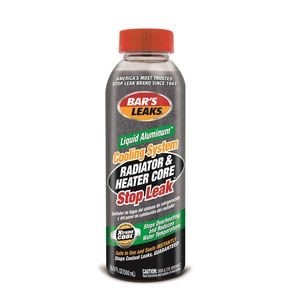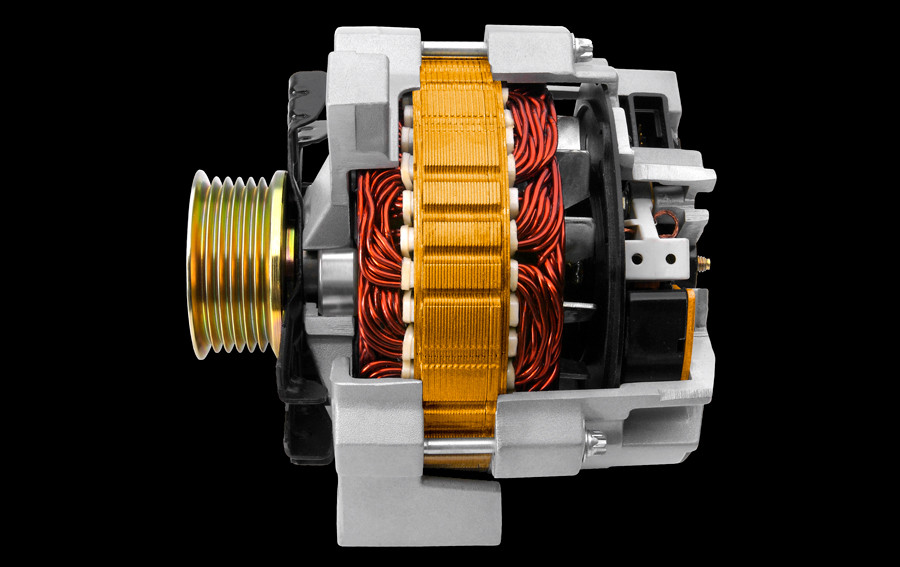How To Fix Deep Scratch and Dent On Car: A Comprehensive Guide
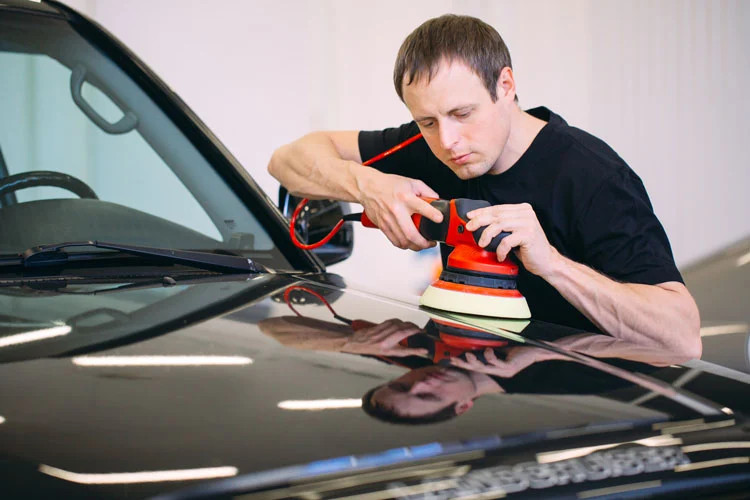
There’s nothing more frustrating than discovering a scratch or dent on your car’s pristine surface. These imperfections can detract from its appearance and potentially lead to more significant problems down the road. But don’t despair. CARDIAGTECH.NET offers a range of auto body repair solutions. In this comprehensive guide, we’ll explore various methods to tackle these blemishes, from DIY fixes to professional repairs, ensuring your car looks its best. We will cover paint correction, body filler application, and automotive refinishing techniques.
1. Understanding the Enemy: Types of Scratches and Dents
Before diving into repair methods, it’s crucial to identify the type of damage you’re dealing with. Different scratches and dents require different approaches.
- Clear Coat Scratches: These are the most superficial, affecting only the clear protective layer of your car’s paint. They often appear as light scuffs or swirl marks.
- Paint Scratches: These penetrate the clear coat and reach the colored paint layer. They’re more noticeable than clear coat scratches and may require more involved repair.
- Primer Scratches: These go through the clear coat and paint, exposing the primer layer underneath. They’re typically deeper and require careful attention to prevent rust.
- Deep Scratches: These are the most severe, reaching the bare metal of your car. They’re highly susceptible to rust and require immediate repair.
- Minor Dents: These are shallow indentations that don’t significantly distort the car’s body panel. They can often be repaired using DIY methods.
- Creases: These are more complex dents that involve sharp bends or folds in the metal. They usually require professional repair.
- Major Dents: These are large, deep indentations that severely distort the car’s body panel. They often require extensive bodywork and painting.
 Car Scratch Types
Car Scratch Types
2. Essential Tools and Materials for Scratch and Dent Repair
Having the right tools and materials is essential for a successful repair. Here’s a list of common items you’ll need:
| Tool/Material | Description | Use Case |
|---|---|---|
| Car Wash Soap | Gentle soap specifically designed for car paint, removes dirt and grime without damaging the finish. | Cleaning the damaged area before and after repairs. |
| Microfiber Towels | Soft, lint-free towels for cleaning, drying, and polishing. | Applying cleaning solutions, waxes, and polishes without scratching the paint. |
| Clay Bar | A pliable compound that removes embedded contaminants from the paint surface. | Preparing the surface for polishing and scratch removal. |
| Masking Tape | Low-tack tape used to protect surrounding areas from accidental damage during sanding and polishing. | Protecting adjacent panels and trim pieces. |
| Sandpaper (Various Grits) | Abrasive paper used to smooth out imperfections and prepare surfaces for painting. | Leveling scratches, feathering edges, and preparing surfaces for primer and paint. |
| Sanding Block | Provides a flat, even surface for sanding, ensuring consistent results. | Achieving a smooth, uniform finish when sanding larger areas. |
| Rubbing Compound | An abrasive compound that removes fine scratches and swirl marks. | Leveling the paint surface and removing imperfections after sanding. |
| Polishing Compound | A less abrasive compound than rubbing compound, used to refine the paint surface and enhance gloss. | Restoring shine and clarity to the paint after using rubbing compound. |
| Car Polish | A non-abrasive product that adds shine and protection to the paint. | Enhancing gloss and providing a protective layer against environmental elements. |
| Wax | Provides a protective barrier against UV rays, water, and other contaminants. | Protecting the paint and maintaining its shine. |
| Touch-Up Paint | Small containers of paint that match your car’s color, used to fill in scratches and chips. | Concealing scratches and chips in the paint. |
| Paint Applicators | Small brushes or swabs used to apply touch-up paint precisely. | Applying touch-up paint neatly and accurately. |
| Body Filler (Bondo) | A paste-like compound used to fill in dents and imperfections in the car’s body. | Repairing dents and creating a smooth, even surface for painting. |
| Spreader | A flexible tool used to apply body filler evenly. | Applying body filler smoothly and uniformly. |
| Primer | A base coat that helps paint adhere to the surface and provides corrosion protection. | Preparing bare metal or body filler for painting. |
| Clear Coat | A protective topcoat that adds shine and durability to the paint. | Protecting the paint and providing a glossy finish. |
| Respirator | Protects your lungs from harmful dust and fumes. | Ensuring respiratory safety when sanding, painting, or working with chemicals. |
| Safety Glasses | Protects your eyes from debris and chemicals. | Protecting eyes from debris, dust, and chemical splashes. |
| Gloves | Protects your hands from chemicals and abrasives. | Protecting hands from chemical irritants and abrasives. |
| Heat Gun | Used to heat up panels to help pop out dents. | Assisting in paintless dent repair by making the metal more pliable. |
| Dent Puller Kit | A kit containing various tools for pulling out dents without damaging the paint. | Facilitating paintless dent repair. |
| Suction Cup Dent Puller | Uses suction to pull out shallow dents. | Assisting in paintless dent repair for minor dents. |
| Slide Hammer Dent Puller | Uses a hammer to pull out larger dents. | Facilitating paintless dent repair for more significant dents. |
CARDIAGTECH.NET offers a wide range of high-quality tools and materials for all your scratch and dent repair needs. Contact us at +1 (641) 206-8880 for expert advice and product recommendations.
3. DIY Scratch Repair Techniques
For minor scratches, you can often achieve satisfactory results with DIY methods. Here are some popular techniques:
3.1 The Toothpaste Method
This is a simple and inexpensive method for removing light scratches.
- Clean the scratched area thoroughly with car wash soap and water.
- Apply a small amount of non-gel toothpaste (preferably whitening toothpaste) to a clean, damp microfiber towel.
- Rub the toothpaste onto the scratch in a circular motion for several minutes.
- Rinse the area with water and dry with a clean microfiber towel.
- Inspect the scratch. If it’s still visible, repeat the process.
3.2 The Scratch Repair Pen Method
Scratch repair pens contain a clear lacquer that fills in shallow scratches, making them less noticeable.
- Clean the scratched area thoroughly.
- Shake the repair pen well.
- Carefully apply the lacquer to the scratch, following the manufacturer’s instructions.
- Allow the lacquer to dry completely.
- Use a clean microfiber towel to buff the area gently.
3.3 The Rubbing Compound Method
Rubbing compound is an abrasive material that can remove fine scratches and swirl marks.
- Clean the scratched area thoroughly.
- Apply a small amount of rubbing compound to a clean microfiber towel or polishing pad.
- Rub the compound onto the scratch in a circular motion, applying moderate pressure.
- As the compound dries, reduce the pressure and continue rubbing.
- Wipe away the excess compound with a clean microfiber towel.
- Follow up with polishing compound and wax to restore shine and protection.
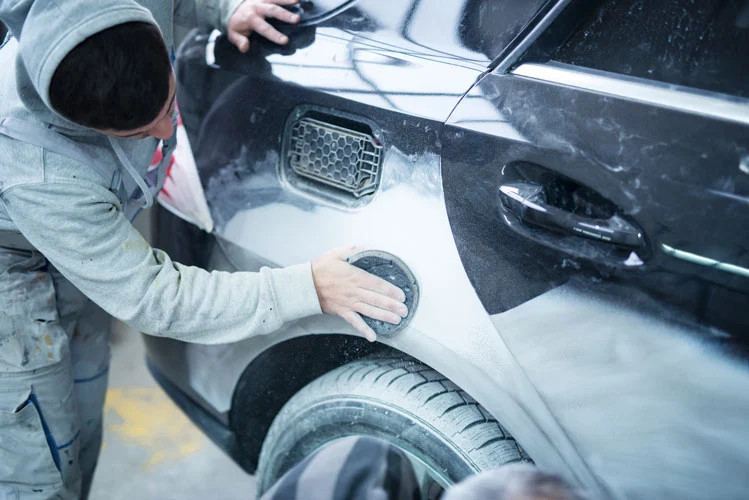 Using Sandpaper to Remove Scratches
Using Sandpaper to Remove Scratches
3.4 The Sandpaper Method
This method is suitable for slightly deeper scratches that haven’t penetrated the primer.
- Clean the scratched area thoroughly.
- Wet a piece of 3000-grit sandpaper with water.
- Gently sand the scratch in a circular motion, applying light pressure.
- Rinse the area with water and inspect the scratch.
- Repeat the sanding process if necessary.
- Use rubbing compound, polishing compound, and wax to restore shine and protection.
4. DIY Dent Repair Techniques
For minor dents, you can try these DIY methods:
4.1 The Plunger Method
This method works best on shallow dents on relatively flat surfaces.
- Clean the dented area thoroughly.
- Wet the rim of a clean plunger (a new one is recommended).
- Place the plunger over the dent, ensuring a good seal.
- Push and pull the plunger vigorously for several minutes.
- Repeat the process until the dent pops out.
4.2 The Hair Dryer and Compressed Air Method
This method uses heat to make the metal more pliable and compressed air to rapidly cool it, causing it to pop back into shape.
- Clean the dented area thoroughly.
- Heat the dent with a hair dryer on its highest setting for several minutes.
- Hold a can of compressed air upside down and spray it onto the heated area.
- The sudden temperature change should cause the metal to pop out.
4.3 The Boiling Water Method
This method is similar to the hair dryer method, but uses boiling water to heat the metal.
- Clean the dented area thoroughly.
- Pour boiling water over the dent, allowing it to heat the metal.
- Reach behind the panel and gently push the dent out.
- Pour cold water over the area to cool the metal and help it retain its shape.
5. Professional Scratch and Dent Repair
For deeper scratches, creases, and major dents, professional repair is often the best option. Here are some common professional techniques:
5.1 Paintless Dent Repair (PDR)
PDR is a technique that involves using specialized tools to massage the metal back into its original shape without damaging the paint. It’s a cost-effective and efficient method for repairing minor to moderate dents.
5.2 Traditional Bodywork
This involves using body filler to fill in dents and imperfections, followed by sanding, priming, and painting. It’s a more involved process than PDR but can repair more severe damage.
5.3 Panel Replacement
In cases of extensive damage, it may be necessary to replace the entire body panel. This is the most expensive option but ensures a perfect repair.
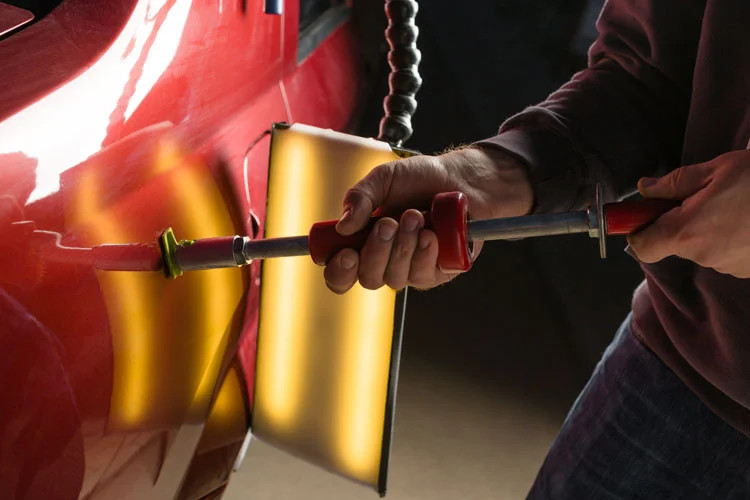 Paintless Dent Repair
Paintless Dent Repair
6. Step-by-Step Guide to Repairing a Deep Scratch
Let’s walk through the process of repairing a deep scratch that has reached the bare metal:
- Preparation: Clean the area around the scratch with car wash soap and water. Dry thoroughly.
- Sanding: Use 320-grit sandpaper to remove any rust or corrosion from the scratch. Feather the edges of the scratch to create a smooth transition.
- Body Filler: Apply a thin layer of body filler to the scratch, following the manufacturer’s instructions. Allow the filler to dry completely.
- Sanding (Again): Sand the body filler with 320-grit sandpaper to level it with the surrounding paint. Gradually increase the grit to 400, 600, and finally 800 to achieve a smooth surface.
- Priming: Apply several thin coats of automotive primer to the repaired area, allowing each coat to dry completely.
- Wet Sanding: Wet sand the primer with 1000-grit sandpaper to create a perfectly smooth surface for painting.
- Painting: Apply several thin coats of automotive paint that matches your car’s color code. Allow each coat to dry completely.
- Clear Coating: Apply several thin coats of clear coat to protect the paint and add shine. Allow the clear coat to dry completely.
- Polishing: Use rubbing compound and polishing compound to blend the repaired area with the surrounding paint.
- Waxing: Apply a coat of wax to protect the paint and enhance its shine.
7. Cost Considerations for Scratch and Dent Repair
The cost of scratch and dent repair can vary widely depending on the severity of the damage, the type of repair method used, and the location of the repair shop.
| Type of Repair | Cost Range | Description |
|---|---|---|
| DIY Scratch Repair | $20 – $100 | Using over-the-counter products like scratch repair pens, rubbing compounds, and polishes. |
| DIY Dent Repair | $30 – $150 | Using tools like plungers, suction cups, and heat guns to pop out minor dents. |
| Professional PDR | $75 – $300 | Repairing dents without damaging the paint, using specialized tools to massage the metal back into shape. |
| Traditional Bodywork | $200 – $1000+ | Filling in dents with body filler, sanding, priming, and painting. The cost depends on the size and complexity of the dent. |
| Panel Replacement | $500 – $2000+ | Replacing the entire damaged body panel. The cost depends on the panel’s price and the labor involved. |
| Full Car Repainting | $3000 – $10000 | Repainting the entire car to match the repaired area perfectly. This is usually done when the damage is extensive or the existing paint is faded or damaged. |
| Hail Damage Repair | $1000 – $20000 | Repairing multiple dents caused by hail. The cost depends on the number and size of the dents. Insurance may cover this type of damage. |
| Car Door Dent Repair | $100 – $500 | Repairing dents and dings on car doors. The cost depends on the severity of the damage and the number of dents. |
| Bumper Scratch Repair | $200 – $7500 | Repairing scratches on the bumper. The cost depends on the depth and size of the scratch. |
8. Preventing Future Scratches and Dents
Prevention is always better than cure. Here are some tips to protect your car from scratches and dents:
- Park in safe locations away from other vehicles and shopping carts.
- Use car covers to protect your car from the elements and accidental scratches.
- Wash and wax your car regularly to maintain its paint and protect it from environmental damage.
- Consider applying a paint protection film to provide an extra layer of defense against scratches and chips.
- Be careful when opening doors in tight spaces.
- Avoid driving on gravel roads or in construction zones.
 Examining Dented Car
Examining Dented Car
9. Why Choose CARDIAGTECH.NET for Your Auto Body Repair Needs?
At CARDIAGTECH.NET, we understand the importance of keeping your car looking its best. That’s why we offer a comprehensive range of high-quality tools, equipment, and materials for all your scratch and dent repair needs.
Here’s what sets us apart:
- Extensive Selection: We carry a wide variety of products from leading brands, ensuring you have access to the best tools and materials on the market.
- Expert Advice: Our team of experienced professionals can provide expert advice and guidance to help you choose the right products for your specific needs.
- Competitive Prices: We offer competitive prices on all our products, ensuring you get the best value for your money.
- Fast Shipping: We offer fast and reliable shipping to ensure you receive your products quickly and efficiently.
- Excellent Customer Service: We’re committed to providing excellent customer service and support.
Don’t let scratches and dents detract from your car’s appearance. Contact CARDIAGTECH.NET today at +1 (641) 206-8880 or visit our website CARDIAGTECH.NET to explore our extensive selection of auto body repair solutions. Let us help you restore your car to its former glory! Our address is 276 Reock St, City of Orange, NJ 07050, United States.
10. Frequently Asked Questions (FAQ) About Scratch and Dent Repair
Here are some frequently asked questions about scratch and dent repair:
- How can I tell if a scratch is deep or just a clear coat scratch?
- A simple test is to run your fingernail across the scratch. If your nail catches on the scratch, it’s likely a deeper scratch that has penetrated the clear coat.
- Can I use touch-up paint on a deep scratch?
- Yes, touch-up paint can be used on a deep scratch, but it’s important to prepare the surface properly first. Sand the scratch, apply primer, and then apply the touch-up paint in thin coats.
- How long does it take to repair a scratch or dent?
- The repair time depends on the severity of the damage and the repair method used. DIY repairs can take a few hours, while professional repairs can take a day or more.
- Will repairing a scratch or dent affect my car’s value?
- Repairing a scratch or dent can actually increase your car’s value, as it improves its overall appearance.
- Is it worth filing an insurance claim for scratch and dent repair?
- It depends on your deductible and the cost of the repair. If the repair cost is less than your deductible, it’s not worth filing a claim. Also, filing too many claims can increase your insurance rates.
- What is the best way to protect my car from future scratches and dents?
- Park in safe locations, use car covers, wash and wax your car regularly, and consider applying a paint protection film.
- Can I repair a dent myself, or should I take it to a professional?
- Minor dents can often be repaired with DIY methods, but larger or more complex dents are best left to professionals.
- What is paintless dent repair (PDR)?
- PDR is a technique that involves using specialized tools to massage the metal back into its original shape without damaging the paint.
- How much does paintless dent repair cost?
- PDR typically costs between $75 and $300, depending on the size and location of the dent.
- Can CARDIAGTECH.NET help me find a professional auto body shop?
- While we don’t directly recommend specific shops, we can provide you with information and resources to help you find a reputable auto body shop in your area. Contact us at +1 (641) 206-8880 for assistance.
By following the tips and techniques outlined in this guide, you can effectively address scratches and dents on your car and keep it looking its best. Remember, CARDIAGTECH.NET is your trusted partner for all your auto body repair needs.



